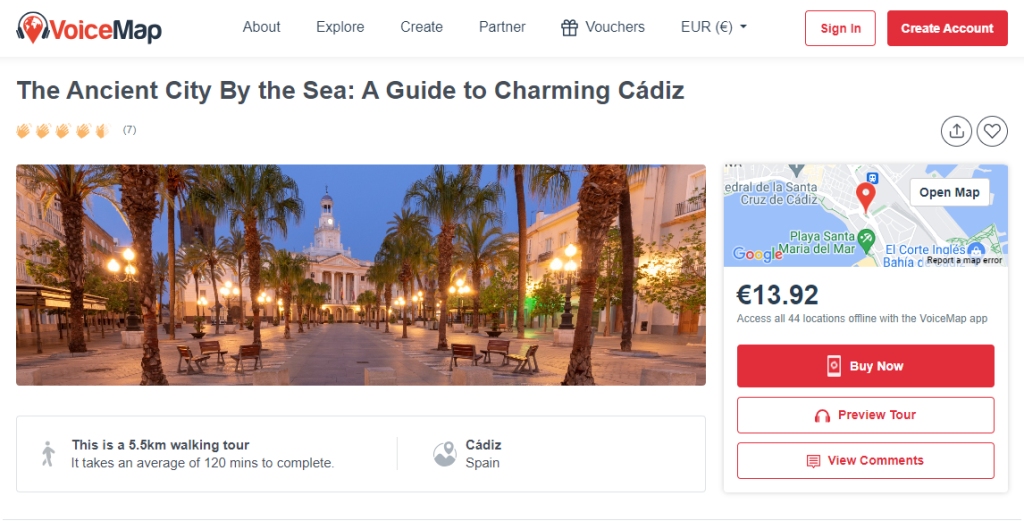The city of Cádiz is reasonably compact. From arriving and discovering the Puerta de Tierra, the Torre Tavira and the Cathedral you will also find that most of the famous and popular monuments and museums are easily within reach. So, here’s Cádiz – A brief tour of the city.
Parking
Parking in Cádiz can be a bit complicated sometimes so check out our dedicated article to help you find a place to park. Or, just head straight to Parkimeter! 🙂
Listen to the podcast about Cádiz – A brief tour of the city
Todays podcast from Mike and Sarah introduces Cádiz, an ancient city in southwestern Spain, highlighting its historical significance as a former trading post and major port.
The audio guided tour of Cádiz

Welcome to Cádiz, often referred to as “La Tacita de Plata,” or “The Little Silver Cup.” I’m Clive, are you ready to immerse yourself in Cádiz’s rich history: A guided audio tour?
I’m excited to lead you on an immersive audio walking tour through Cádiz, where history, culture, and romance intertwine with VoiceMap.
Buy the audio guide here: https://voicemap.me/tour/cadiz/the-ancient-city-by-the-sea-a-guide-to-charming-cadiz (Or, just scan the QR code with your mobile phone.)
More about Cádiz from the past to present day
Cádiz is a historic city located in the southwestern part of Spain, known for its rich history dating back to the Neolithic period. The Phoenicians established a trading post in the area around 1100 BCE, and the city was later conquered by the Romans.
During the Middle Ages, Cádiz was a thriving port city and center of trade and commerce, and in the 16th and 17th centuries, it was a major center of the Spanish empire.
In recent years, Cádiz has become a popular tourist destination, offering a variety of museums, hostels, hotels, tourist information centers, and guided tours. Whether you’re interested in exploring the city’s history, culture, or just looking for a place to stay, Cádiz has something to offer everyone
Recommended guided tours in Cádiz
La Tacita de Plata
Situated on a narrow slice of land surrounded by the sea‚ Cádiz is a typically Andalusian city with well-preserved historical landmarks and some fantastic beaches.
The older part (within the remnants of the city walls) is commonly referred to as the old Town (Casco Antiguo). Here there are various neighborhoods known as barrios. Among them El Pópulo, La Viña, and Santa María are the most well known.
Origins of “La Tacita de Plata”?
Cádiz is often referred to as “La Tacita de Plata,” which translates to “The Little Silver Cup” and this poetic nickname has produced a lot of debate over the years.
- One interpretation is that the city’s bay, particularly during sunsets, reflects the silver-like hues of the sea, giving it a resemblance to a shining silver cup.
- That said, Cádiz has a rich maritime history and was a significant port during Spain’s colonial period. The silver nickname might be a nod to the wealth brought back from the Americas during the age of discovery.
- On the same lines though, others suggest that the term originates from the city’s historical connection to trade, commerce, and wealth, symbolized by the image of a silver cup.
While the exact origin may be debated, the nickname “La Tacita de Plata” is a testament to the city’s beauty, history, and cultural significance and reflects the romantic and poetic character often associated with Cádiz.
This promo clip by Cádiz Turismo shows some highlights of the city
Whilst the Old City’s street plan consists of narrow winding alleys connecting large plazas, newer areas of Cádiz typically have wide avenues and more modern buildings. In addition, the city is dotted with numerous parks and gardens.
There are many beautiful churches, museums, wonderful coffee shops, restarants and tapas bars for a day visit. But, to really get the most out of Cádiz, why not book a hotel, stay with us for a few days and immerse yourself into “Gadir”, the place regarded as the most ancient city still standing in Western Europe.
Don’t forget as well the Santa Catalina Castle, The Plaza de España, The Central Market and Plaza de la Flores , The beautiful “Hidden Tower or Bella Escondida“, the Roman Theatre, the ruins of Gadir and the Plaza of San Juan de Dios
Remember! After you have checked in to your hotel or other acommodation or even if you are just here for a day trip, your first visit should be one of the main tourist offices. You’ll find all the most up to date information including places to visit, events and everything else you need to get the best out of a visit to Cádiz. Details and where to find them here: https://visitingcadiz.com/the-main-tourist-offices-in-cadiz/
Thanks for supporting Visiting Cádiz by using the links to Guides, hotels and other activities! We get a small commission and that helps us to help you!
Frequently Asked Questions About Cádiz
Cádiz is affectionately known as “La Tacita de Plata,” or “The Little Silver Cup.” While its exact origin is unclear, one theory links it to the way the bay reflects silver hues at sunset. Others suggest it symbolizes Cádiz’s wealth during its maritime and colonial peak—when silver and riches flowed through its busy port.
Cádiz is considered the oldest continuously inhabited city in Western Europe. Originally founded by the Phoenicians around 1100 BCE, it later flourished under Roman rule and became a major port during Spain’s Golden Age. Its long-standing role in trade and exploration gives it a deep historical identity.
The Old Town (Casco Antiguo) is compact, with narrow alleys leading to broad plazas. Key neighbourhoods include El Pópulo, La Viña, and Santa María. The newer parts of the city feature wide boulevards and modern buildings, while parks and gardens add green space across both areas.
Highlights include the Cathedral, Torre Tavira, Puerta de Tierra, and Santa Catalina Castle. You can also explore the Roman Theatre, the archaeological site of Gadir, the Plaza de las Flores, the Central Market, and the “Hidden Tower” (Bella Escondida). Museums, tapas bars, and plazas make Cádiz ideal for casual exploring.
Yes. Cádiz is best explored on foot. The historical centre is flat and compact, and many of its major attractions are located within a short walking distance from each other and from the cruise port.
Cádiz has several tourist offices offering local maps, event info, and guidance. The Visiting Cádiz website provides insider guides on hotels, parking, flamenco venues, walking tours, and more. There’s also a self-guided audio tour available for deeper exploration.
Parking in Cádiz can be tricky due to narrow streets and limited space. Booking in advance through platforms like Parkimeter helps. Dedicated guides on the site offer practical tips for finding parking near popular attractions.
Yes. The author of Visiting Cádiz also runs guides for Ronda (“The City of Dreams”), Grazalema, and the Caminito del Rey. Nature lovers can explore Spanish wildlife with Wildside Holidays.
Cádiz appeals to all kinds of visitors—history lovers, beachgoers, foodies, and cultural explorers. Its variety of museums, monuments, beaches, and tapas bars makes it ideal for both short visits and longer stays. Whether you’re cruising in for a few hours or staying several days, there’s something here for everyone.
I’ve been living in this lovely area of Western Andalucia for the last 20 years or so and dedicate most of my time to the running of English language tourist information websites for the towns of Cádiz, Ronda, Grazalema, the famous or infamous Caminito del Rey, and also Wildside Holidays, which promotes sustainable and eco-friendly businesses running wildlife and walking holidays in Spain. My articles contain affiliate links that will help you reserve a hotel, bus, train or activity in the area. You don’t pay more, but by using them you do support this website. Thankyou!


